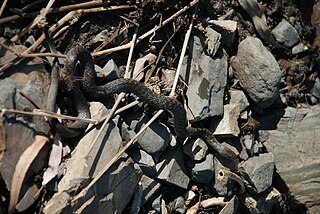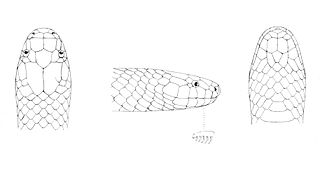
The common keelback, also known as Mair's keelback, is a species of nonvenomous snake in the family Colubridae. The species is endemic to Australasia.

The woma python, also known commonly as Ramsay's python, the sand python, and simply the woma, is a species of snake in the family Pythonidae, endemic to Australia. Once common throughout Western Australia, it has become critically endangered in some regions.

Uropeltis ellioti, commonly known as Elliot's earth snake and Elliot's shieldtail, is a species of snake in the family Uropeltidae. The species is endemic to India.

Hypsiglena jani, commonly known as the Texas night snake or the Chihuahuan night snake, is a small species of mildly venomous snake in the family Colubridae. The species is native to the southwestern United States and adjacent northeastern Mexico.

Tantilla hobartsmithi, commonly known as the southwestern blackhead snake, is a species of small colubrid snake native to the southwestern United States and northern Mexico.

The amethystine python, also known as the scrub python or sanca permata in Indonesian, is a species of non-venomous snake in the family Pythonidae. The species is found in Indonesia and Papua New Guinea. Popular among reptile enthusiasts, and noted for its coloration and size, it is one of the largest snakes in the world, as measured either by length or weight, and is the largest native snake in Papua New Guinea. Until 2000, the larger S. kinghorni was generally considered a subspecies of S. amethistina, and this change of classification has still not been universally reflected in literature. Because of this issue, S. amethistina has often been described as the largest snake in Australia, but this is not accurate since under the current classification, this species does not occur in Australia.
Bothrops medusa is a venomous pitviper species endemic to Venezuela. No subspecies are currently recognized.
The spotted mulga snake, also known commonly as Butler's black snake and Butler's snake, is a species of venomous snake in the family Elapidae. The species is endemic to Western Australia. It is a member of the genus Pseudechis, dangerously venomous snakes that can intimidate an opponent by raising the head and presenting a hood. This cobra-like threat display is supported by the ability to produce a very large amount of venom.

The peach-throated monitor, also known commonly as the Sepik monitor, is a species of monitor lizard in the family Varanidae. The species is native to New Guinea.

Hydrophis peronii, commonly known as the horned sea snake, Peron's sea snake, and the spiny-headed seasnake, is a species of venomous snake in the subfamily Hydrophiinae of the family Elapidae. The species is endemic to the western tropical Pacific Ocean. It is the only sea snake with spines on the head. It is sometimes placed in its own genus Acalyptophis.
Aipysurus duboisii, also known commonly as Dubois' sea snake and the reef shallows sea snake, is a species of extremely venomous snake in the subfamily Hydrophiinae of the family Elapidae. Its geographic range includes Papua New Guinea, New Caledonia and the northern, eastern and western coastal areas of Australia, that is the Coral Sea, Arafura Sea, Timor Sea and Indian Ocean. It lives at depths up to 80 meters in coral reef flats, sandy and silty sediments which contain seaweed, invertebrates and corals or sponges that can serve as shelter. It preys upon moray eels and various fish that live on the seafloor, up to 110 cm in size. A. duboisii is viviparous, giving birth to live young rather than laying eggs. It displays medium aggressiveness, i.e., will bite if provoked, but not spontaneously. The fangs are 1.8 mm long, which are relatively short for a snake, and the venom yield is 0.43 mg. Aipysurus duboisii is a crepuscular species, meaning that it is most active at dawn and dusk.
The Pilbara death adder, also known commonly as Wells' death adder, is a species of venomous snake in the family Elapidae. The species is one of the eight members of the genus Acanthophis, a genus which is found throughout northwestern and southwestern Australia and some parts of southern Papua New Guinea. The species Acanthophis wellsi is endemic to Western Australia.

Platyceps karelini, the spotted desert racer, is a species of snake in the family Colubridae. The species is endemic to Asia.
The spotted dagger-tooth tree snake is a species of venomous snake in the family Colubridae. The species is indigenous to Middle Africa.

D'Albertis' python, also known commonly as D'Albert's water python or the northern white-lipped python, is a species of python, a non-venomous snake in the family Pythonidae. The species is endemic to New Guinea. There are no subspecies that are recognized as being valid.
Bamanophis is a genus of snake in the family Colubridae. The genus contains the sole species Bamanophis dorri, which is native to West Africa.
Nguyenvansang's snake is a species of snake in the family Colubridae. The species is endemic to Vietnam.
The ridgehead snake is a species of snake in the family Colubridae. The species is endemic to southeastern Mexico.

Toxicocalamus loriae, also known commonly as the Loria forest snake, is a species of venomous snake in the family Elapidae. The species is endemic to New Guinea and occurs in both Western New Guinea (Indonesia) and Papua New Guinea.
Stegonotus guentheri, also known commonly as the D'Entrecasteaux Archipelago ground snake and the Milne Bay ground snake, is a species of snake in the subfamily Colubrinae of the family Colubridae. The species is endemic to Papua New Guinea.











